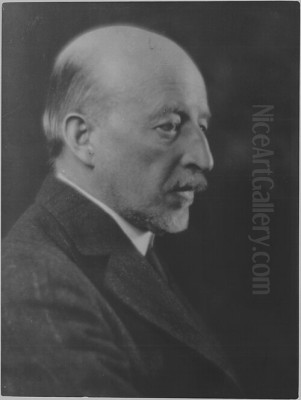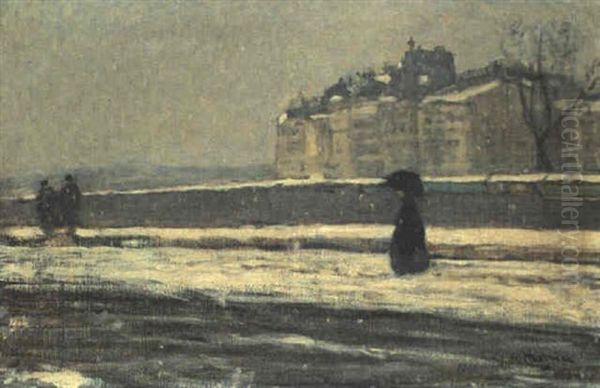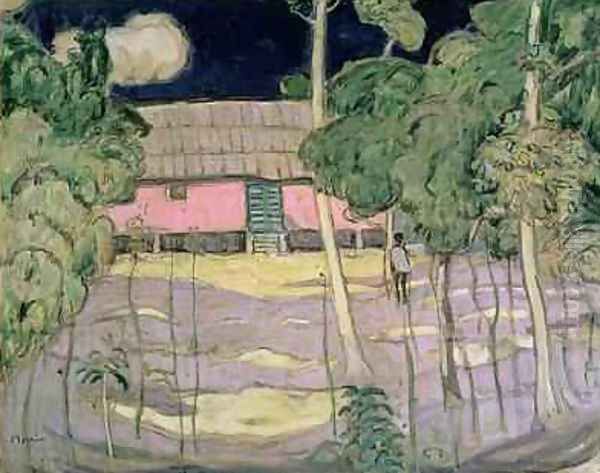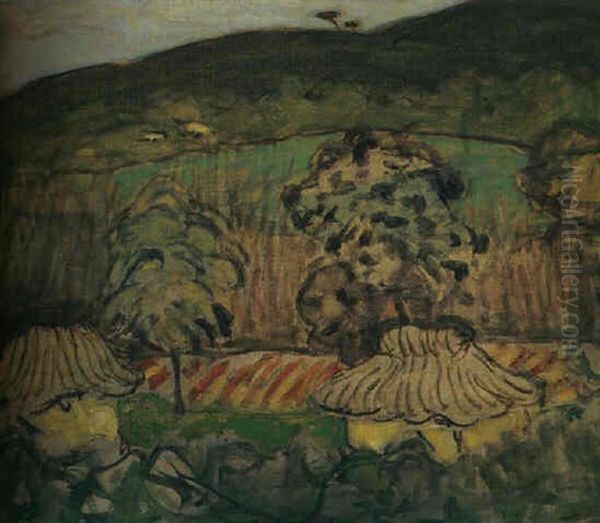Introduction: Bridging Worlds Through Art

James Wilson Morrice stands as one of Canada's most celebrated expatriate painters, a pivotal figure who brought the currents of European modernism to Canadian art while achieving significant recognition abroad. Born into a prosperous Montreal family on August 10, 1865, Morrice forged a path distinct from his contemporaries, spending the majority of his productive life immersed in the vibrant artistic milieu of Paris and travelling extensively. Primarily known as a landscape painter, his work captured the subtle beauties of diverse locales, from the snow-laden streets of Quebec to the sun-drenched shores of North Africa and the West Indies, all rendered with a sophisticated understanding of colour and light that evolved throughout his career. His legacy is that of a cosmopolitan artist whose sensitive eye and refined technique left an indelible mark on both Canadian and international art scenes.
Early Life and the Call of Art
James Wilson Morrice's journey into the art world was not immediate. Born in Montreal, Quebec, his family's wealth, derived from mercantile interests, provided him with a privileged upbringing and education. Following familial expectations, he initially pursued a more conventional path, studying law at the University of Toronto and Osgoode Hall, being called to the Ontario Bar in 1889. However, his passion lay elsewhere. Even during his legal studies, he sketched and painted, demonstrating a clear inclination towards the visual arts.
Recognizing his son's true calling, Morrice's father provided him with the financial means to pursue art seriously. This support enabled Morrice to leave Canada for Europe in 1890, a move that would define the rest of his life and career. He initially travelled through England and the Netherlands before settling in Paris, the undisputed centre of the art world at the time. This relocation marked the definitive end of his legal aspirations and the beginning of his full commitment to painting.
Parisian Training and Impressionist Influences

Upon arriving in Paris, Morrice sought formal training to hone his burgeoning talent. He briefly studied at the Académie Julian, a renowned private art school that attracted students from around the globe. There, he encountered fellow artists who would become significant figures, including the American painters Maurice Prendergast and Robert Henri, and the Australian Charles Conder. While the academic training provided a foundation, Morrice was perhaps more profoundly shaped by the artistic atmosphere of Paris itself.
He took lessons from the Barbizon-influenced landscape painter Henri Harpignies, whose emphasis on direct observation of nature resonated with Morrice. However, it was the pervasive influence of Impressionism and its aftermath that truly began to shape his aesthetic. The works of Claude Monet, with their focus on capturing fleeting moments of light and atmosphere, were particularly impactful. Morrice absorbed these lessons, moving away from tighter, more traditional rendering towards a looser brushwork and a greater sensitivity to tonal values.
An early, significant influence was the American expatriate James McNeill Whistler. Morrice admired Whistler's sophisticated tonal harmonies, subtle colour palettes, and evocative, atmospheric cityscapes and nocturnes. This influence is apparent in Morrice's earlier works, particularly in his depictions of Parisian scenes and Venetian canals, which often feature muted colours and a focus on mood over precise detail. He learned from Whistler the art of suggestion and the importance of aesthetic arrangement.
Developing a Personal Style: Colour, Light, and Landscape
While initially influenced by Whistler and the Impressionists, Morrice quickly developed a distinctive artistic voice. He became known for his exquisite sense of colour, often employing subtle harmonies and unexpected juxtapositions. His palette frequently featured soft blues, greys, mauves, and pinks, particularly effective in his depictions of snow scenes in his native Canada, which he visited periodically during the winters. These Canadian landscapes are among his most celebrated works, capturing the unique light and quiet beauty of the winter season with remarkable sensitivity.
Morrice developed a practice of painting small oil sketches on wooden panels, known as pochades. These were executed outdoors, directly capturing the light and atmosphere of a scene. Back in his studio, he would use these sketches as references for larger canvases. This method allowed him to retain the freshness and spontaneity of direct observation while composing more finished works. His technique involved applying paint in thin layers, often allowing the texture of the canvas or panel to show through, contributing to the vibrancy and luminosity of his surfaces.

His travels provided a constant source of inspiration and led to stylistic evolution. Visits to Venice resulted in luminous depictions of canals and lagoons, echoing Whistler but with Morrice's own delicate touch. His time spent in North Africa, particularly Tangier in Morocco and Tunis, introduced a brighter palette and bolder compositions, reflecting the intense light and vibrant culture of the region.
Encounters in Tangier: Matisse and Fauvism
A significant chapter in Morrice's artistic development occurred during his visits to Tangier, Morocco, particularly in the winters of 1911-12 and 1912-13. It was here that he formed a friendship and working relationship with the French master Henri Matisse. Matisse, a leading figure of Fauvism, was known for his radical use of intense, non-naturalistic colour and bold, expressive forms.
Working alongside Matisse, Morrice's own palette brightened considerably. While he never fully adopted the Fauvist aesthetic, the experience encouraged him to experiment more freely with colour and to simplify forms. His Tangier paintings, such as Marketplace, Tangier, exhibit a heightened chromatic intensity and a more decorative approach to composition compared to his earlier work. This period demonstrates Morrice's openness to contemporary trends and his ability to integrate new influences into his established style without sacrificing his personal vision. Their mutual respect is evident; Matisse reportedly admired Morrice's sensitivity to colour. Their circle in Tangier also included other artists like Albert Marquet and the British painter Simon Bussy.
Travels and Themes: From Quebec to the Caribbean
Morrice was an inveterate traveller. Beyond his regular winter trips back to Canada and his time in France and North Africa, his quest for new subjects took him across Europe and eventually to the Caribbean. Each location offered new motifs and challenges of light and colour. His paintings capture Parisian life along the Seine, such as Quai des Grands-Augustins (now in the Musée d'Orsay), the bustling ports of Concarneau and Saint-Malo in Brittany, and the tranquil beauty of the French countryside.
His Canadian scenes remain iconic, particularly those depicting Quebec City, such as The Ferry, Quebec and Winter Street, Quebec. These works convey not just the physical appearance of the landscape but also its atmosphere – the crisp air, the muffled silence of snowfall, the warm glow of lights against the cold. He captured the essence of the Canadian winter with a poetic sensibility that resonated deeply both at home and abroad.

Later in his life, seeking warmer climates for health reasons and new artistic stimuli, Morrice travelled to the West Indies, including Trinidad, Cuba, and Jamaica. These tropical locales inspired works characterized by lush vegetation, brilliant light, and vibrant local colour, as seen in paintings like House in Santiago and works titled Trinidad or West Indies. These later works often show a continued interest in simplified forms and expressive colour, reflecting the lasting impact of his encounters with modernism.
Recognition and Exhibitions
Throughout his career, Morrice achieved considerable recognition in the international art world. He exhibited regularly at prestigious venues in Paris, including the Société Nationale des Beaux-Arts and, significantly, the Salon d'Automne. He was not just an exhibitor at the Salon d'Automne; he was elected Vice President of the hanging committee in 1908, a testament to the respect he commanded among his Parisian peers.
His work was also shown in London, notably with the International Society of Sculptors, Painters and Gravers, an organization led for a time by Auguste Rodin and previously by Whistler. He gained significant international acclaim when he became the first Canadian artist to be represented in the Venice Biennale in 1903, exhibiting works inspired by his visits to the city. These Venetian scenes were also shown with success in Munich.
In Canada, Morrice was elected a member of the Royal Canadian Academy of Arts (RCA) in 1913. Although he spent most of his time abroad, he maintained connections with the Canadian art scene, exhibiting occasionally with the Canadian Art Club and influencing younger generations of Canadian painters who were looking towards European modernism, including members of the future Group of Seven like A.Y. Jackson and Lawren Harris, who admired his sophisticated approach. His work was acquired by major Canadian institutions, including the National Gallery of Canada and the Montreal Museum of Fine Arts.
Interactions with Contemporaries
Morrice moved easily within the artistic and literary circles of his time. His friendships extended beyond the painters he met during his studies or in Tangier. In Paris, he was part of a lively expatriate community and was known for his quiet charm and sociability, often frequenting cafes like the Chat Blanc. His circle included writers such as Somerset Maugham, who is said to have based the character Cranshaw in his novel Of Human Bondage partly on Morrice, and Arnold Bennett, who also captured aspects of the Parisian art scene in his writings.
His connection with fellow Canadian painter Maurice Cullen was also important. Both artists shared an interest in capturing the effects of light, particularly in Canadian winter landscapes, and they maintained contact and mutual respect throughout their careers. While Morrice's style was generally more aligned with French Post-Impressionism and Cullen's closer to Impressionism, they both played crucial roles in modernizing Canadian landscape painting. Other contemporaries whose work Morrice would have known well include Post-Impressionists like Paul Gauguin and Vincent van Gogh, whose expressive use of colour and form were transforming European art.
Later Years and Legacy
The outbreak of World War I disrupted Morrice's life and travels. He spent part of the war in London and France. Although commissioned as a war artist by the Canadian government, his poor health, exacerbated by alcoholism, limited his output in this capacity. He produced some sketches of troop movements but struggled to complete larger canvases related to the war effort.
After the war, his health continued to decline. He sought refuge in warmer climates, returning to North Africa and the Caribbean. His later works, while sometimes showing a diminished energy, retain his characteristic sensitivity to colour and atmosphere. James Wilson Morrice died in Tunis on January 23, 1924, at the age of 58. His death occurred far from his native Canada, yet his artistic legacy profoundly shaped its development.
Morrice is remembered as Canada's first truly modern painter, an artist who successfully synthesized international influences into a unique personal style. He introduced a sophisticated understanding of Post-Impressionist aesthetics to Canadian art, moving beyond literal representation towards a more subjective and expressive interpretation of landscape and figure. His subtle, evocative paintings continue to be admired for their technical refinement, emotional depth, and timeless beauty. His work serves as a vital link between 19th-century traditions and the burgeoning modernism of the 20th century, securing his place as a key figure in Canadian art history. His paintings are held in major collections across Canada, in the United States, and in Europe, including the National Gallery of Canada, the Montreal Museum of Fine Arts, the Art Gallery of Ontario, and the Musée d'Orsay in Paris.